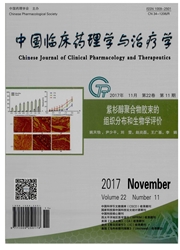

 中文摘要:
中文摘要:
目的:探讨急慢性迷走神经刺激(VNS)对大鼠海洛因复吸行为可能的干预作用及机制。方法:SD大鼠每天进行4h的海洛因自身给药训练,持续14d,建立具有强迫性觅药和给药特征的自身给药模型。随后所有大鼠植入VNS电极,恢复后进行10d的海洛因觅药行为消退训练,期间分组给予急性VNS、慢性VNS或假刺激。消退结束后测定各组大鼠条件性线索诱导下的海洛因觅药行为的恢复(即海洛因复吸行为)。免疫荧光法检测中枢核团c-Fos的表达水平。结果:海洛因复吸行为测定结果显示,与假刺激对照组比较,急性VNS组和慢性VNS组的有效鼻触数均明显降低(P〈0.01)。免疫荧光的结果显示,与对照组比较,急性VNS组(P〈0.05)和慢性VNS组(P〈0.01)中央杏仁核(Ce)的c-Fos表达水平均明显降低,而边缘下区(IL)的c-Fos表达水平均明显升高(P〈0.05)。结论:急慢性VNS均能够显著抑制大鼠的海洛因复吸行为,其机制可能与Ce和IL脑区神经元激活的改变有关。
 英文摘要:
英文摘要:
To investigate the therapeu- tic effect of vagus nerve stimulation (VNS)on heroin relapse in rats and its possible mecha- nism. METHODS: The SD rats were trained to self-administer heroin by nose-poking in a daily 4 hours session for consecutive 14 days,to estab- lish an animal model of compulsive drug seeking and drug-taking. The electrode was implanted into the left vagus nerve and followed hy several days recovery, all rats were then trained to 10daily extmction groups: sham control, acute VNS and chronic VNS. The rats in the chronic VNS group were given VNS 2 hours be{ore all extinction and re- lapse test session, while the rats in the acute VNS group were given VNS 2 hours only be{ore relapse test session. Cue-induced heroin relapse test were measured 24 hours atter last extinction session. Atter relapse testing, c-Fos levels in brain regions of rats were measured by immuno-fluorescence. RESULTS: Compared with sham group,the active nose-poking of acute VNS and chronic VNS were all significantly decreased (P 〈0.01 ). The immunofluorescence results showed that the numbers of c-Fos immuno-posi- tire neurons in central amygdala (Ce) were sig- nificantly decreased after acute VNS (P〈0.05) or chronic VNS (P〈0.01) compared with sham control. However, the numbers of c-Fos immu- no-positive neurons in the infralimbic cortex (IL) were significantly increased in both acute VNS and chronic VNS group(P〈0.05). CON- CLUSION: Acute VNS or chronic VNS may in- hibit cue-induced heroin relapse of rats, the pos- sible mechanism might be associate with the al- teration of neuron activity in Ce and IL.
 同期刊论文项目
同期刊论文项目
 同项目期刊论文
同项目期刊论文
 Positive association between-1021 TT genotype of dopamine beta hydroxylase gene and progressive beha
Positive association between-1021 TT genotype of dopamine beta hydroxylase gene and progressive beha Low dose risperidone attenuates cue-induced but not heroin-induced reinstatement of heroin seeking i
Low dose risperidone attenuates cue-induced but not heroin-induced reinstatement of heroin seeking i Galantamine attenuates the heroin seeking behaviors induced by cues after prolonged withdrawal in ra
Galantamine attenuates the heroin seeking behaviors induced by cues after prolonged withdrawal in ra Electroacupuncture Suppresses Discrete Cue-Evoked Heroin-Seeking and Fos Protein Expression in the N
Electroacupuncture Suppresses Discrete Cue-Evoked Heroin-Seeking and Fos Protein Expression in the N 期刊信息
期刊信息
